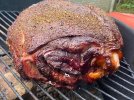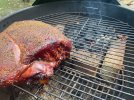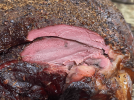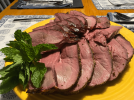Twas Mother's Day eve supper for 11. Bone-in leg was from a white tail doe, aged whole for 21 days. Leg was dry rubbed and marinated for a day then indirect smoked over charcoal and mesquite for 4.5 hours - until 125F internal temp was reached. Allowed to rest for a hour before carving. Served it with charred scallion/jalapeno relish. Well worth the wait to get the family together for these "whole-beast roasts."
-
If you are being asked to change your password, and unsure how to do it, follow these instructions. Click here
You are using an out of date browser. It may not display this or other websites correctly.
You should upgrade or use an alternative browser.
You should upgrade or use an alternative browser.
Dry Aged White Tail Leg for Mother's Day
- Thread starter JTComfort
- Start date
 Help Support Long Range Hunting Forum
Help Support Long Range Hunting Forum
I give up. How (what method) did you dry age the hind quarter for 21 days? I never get that many dry (low humidity) days in a row. I envy you! And I would like to learn without having to waste a hind leg of venison. Skipglo may also want to know!Twas Mother's Day eve supper for 11. Bone-in leg was from a white tail doe, aged whole for 21 days. Leg was dry rubbed and marinated for a day then indirect smoked over charcoal and mesquite for 4.5 hours - until 125F internal temp was reached. Allowed to rest for a hour before carving. Served it with charred scallion/jalapeno relish. Well worth the wait to get the family together for these "whole-beast roasts."
I live in VA and we rarely get the conditions right for this opportunity. I haven't hung a deer in 5 seasons and was only able to hand this one b/c of a cold snap near the end of the season, so it is a rare treat.I give up. How (what method) did you dry age the hind quarter for 21 days? I never get that many dry (low humidity) days in a row. I envy you! And I would like to learn without having to waste a hind leg of venison. Skipglo may also want to know!
I hang in my garage, the whole animal, skin on. Even temperatures, good air circulation, in a shaded area that is pest free is best. Before hanging on a gambrel is inspected the carcass, trimmed back excess belly skin remove the tenderloins. You may leave the head on or not - I have been removing heads for CWD testing, taking the tongue and inspecting for sinus bot flies - YMMV
Wash the cavity with water, dry it, then vinegar, then rub with salt to help create a cuticle. Prop the cavity open. I run a fan and a dehumidifier to keep the air moving. Conditions do have to be "just right" - ideally, temperature under 40 degrees and humidity under 50% - and you have to be ready to process on relatively short notice if the weather dictates. Inspect daily for any off-odors or bacterial growth - mold is not a bad thing, it can be cut away.
Temperature spikes to 50 or so during the day are okay as long as they are short and the meat is out of direct sunlight (and warming) - persistent temperatures too high will result in spoilage. The temperature of the meat is more important to monitor than the air temp. If ambient temperatures dip below 28, the aging process will be slowed and if it really takes a dive into the single digits, will stop altogether - and skinning a frozen animal is NO FUN. Meat will not freeze at 32, so "frozen" solid will occur when temps are very low for a couple days.
Hanging skin on slows the drying time down and also reduced the amount of meat that is lost when processing. The skin will come off very easily after a week of hanging. I've let deer go as long as 30 days and the result was incredible. Test for texture by firmly pressing your thumb into the inside of the leg. When the meat springs-back more slowly and a slight depression remains, the meat is aging well and the texture will be exceptional.
When you've determined that your animal is aged long enough or conditions require it's time to process. Remove the skin then sanitize your area - process as usual. As you butcher, trim away any cuticle (hard dried skin) which should only be the cavity, part of the neck and inner hindquarters, and any shot-through areas. Inspect as you go for any irregularities.
I am a professional chef and restaurateur and I learned this process from an Icelandic certified game butcher, chef and dear friend. We have aged everything from woodcock to elk with exceptional results. A $50 used side-by-side fridge/freezer served as an aging locker during the years we had a duck lease on the Eastern Shore. I've never had better Canada goose on the table after 3 weeks of hanging with feathers on and guts in. The Europeans have been doing this for 100s of years - good cooking techniques still apply. Unless we're fortunate enough to have a cold locker, conditions are not always favorable, locations vary and and each animal is different. Continuous observation is key to watching the process unfold - having a mentor is helpful. Happy to answer any questions - PM me. It has been a gustatory journey of discovery over the last 30 years with many amazing meals.
BillLarson
Well-Known Member
Boy,now thats quite a process.
I hunt in snow country... and usually ....during bow season we have warm weather squirts.
We usually skin our deer the day of kill and sometimes butcher then...or next day....
Not saying your way is wrong.... i,ve been throughout Europe and can attest to your methods.
You can smell a bucther shop from a block away.
I would get kicked outa any deer camp in the area if I even suggested such a process...
I hunt in snow country... and usually ....during bow season we have warm weather squirts.
We usually skin our deer the day of kill and sometimes butcher then...or next day....
Not saying your way is wrong.... i,ve been throughout Europe and can attest to your methods.
You can smell a bucther shop from a block away.
I would get kicked outa any deer camp in the area if I even suggested such a process...
That is really interesting to hear the process. Years ago some of the guys talked about the old timers aging deer. They would leave it hang for 2-3 weeks and would be moldy in the chest cavity before processing.
I've always wanted to try this so your info really helps. Thanks for the write up.
I've always wanted to try this so your info really helps. Thanks for the write up.
epags
Well-Known Member
@ TJComfort - When I was stationed in Alaska, one of my tasks was to go to Point Barrow. The locals there had racks for aging ducks. I saw rows of two ducks, feathers on and un-gutted that were tied neck to neck then draped over the horizontal rack pole to age. I was told they remain that way until needed. Sounds like something similar to the European method maybe?
Used to hunt waterfowl with a family of Irish decent that used to shoot ducks and geese all week and hang on close line by neck. Then pluck and eviscerate on Sunday. In those days no Sunday hunting. Some birds would be green around back end. Cleaned them and package. Have had many meals at their dinner table over the years. Great tasting birds. No ill effects.
Thanks for this …. Very interesting!, we have always left game hanging for at least 7 days, skin on, unless weather just didn't allow…. Early deer hunts, too warm, late elk hunts sometimes to cold and they just freeze solid. As a general rule we like to let them hang, but this would be great to try, if conditions allow.
I get the hairy - "Are you really going to eat that?" - eyeball when I pull hearts, kidneys, livers and caul fat out of gut piles. LOL. We eat the whole beast.Boy,now thats quite a process.
I hunt in snow country... and usually ....during bow season we have warm weather squirts.
We usually skin our deer the day of kill and sometimes butcher then...or next day....
Not saying your way is wrong.... i,ve been throughout Europe and can attest to your methods.
You can smell a bucther shop from a block away.
I would get kicked outa any deer camp in the area if I even suggested such a process...
Thanks for sharing that - I'll bet those are great meals! Some old English cookbooks refer to choosing birds that were "well hunge" - this meant that their necks were elongated, eyes sunk. We even hang our Mourning Doves for a few days if they're not too badly hit.Used to hunt waterfowl with a family of Irish decent that used to shoot ducks and geese all week and hang on close line by neck. Then pluck and eviscerate on Sunday. In those days no Sunday hunting. Some birds would be green around back end. Cleaned them and package. Have had many meals at their dinner table over the years. Great tasting birds. No ill effects.
Some game books talk about it, but I've never seen anything really codified. I have written about it and made some posts in various forums. After reading Steve Rinella's "Scavenger's Guide to Haute Cuisine" in 2006, I tossed around a book idea and even proposed a Food Network program. I erred by pursuing the culinary route - FoodNetwork doesn't really do guns or death. I've heard Steve touch on it, but I haven't read his more recent books. I am guessing that it's such a niche interest that there's not a lot of market value in talking about it at length. Culturally, our consumption of wild game is so low that a conversation about antiquated handling practices from Old Europe is just not interesting and Steve seems to be playing to a different crowd these days.Should have asked - are there specific cook books/books you may suggest that expound on the process or specific ways to cook?
"Larousse Gastronomique" - first published in 1938 discussed the technique, but does not state exact times. "Until it develops a marked smell" or "until the breast turns green" these are extremes, but not beyond the realm. Ground game (hares and such) are noted as being hung for 2-4 days. On birds, woodcock are said to require the longest aging, but no specifics other than not "drawn" (feathers on, guts in). Poorly shot game is dismissed as not suitable for aging. For really elevated recipes for game, go to Europe - French or Spanish contemporary chefs - they have the culture for market hunting. And Escoffier can not be beat for the true classics of French cuisine. Fergus Henderson in Nose to Tail Eating has a number of good recipes for game birds and offal. Mark Miller in Coyote Cafe has some tremendous recipes for game that are modern and reflect the desert southwest. .
I post and share what I know largely because I don't see or hear much about it in the mainstream. I'd like to think that I might inspire someone else as I was inspired. The results are very rewarding and the process is arcane. I can tell you truthfully that to the many non-cook/non-hunters that I have served well aged game, most will acknowledge they've never had game like it.
BTW - TSA might look at you weird, but there is no law against traveling domestically (Rapid City to VA) with a limit of intact dead pheasants in your checked bag. I haven't tried carry on.



